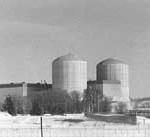Maryland rejects PATH transmission line
September 10th, 2009
Potomac Appalachian Transmission Highline
The Washington Post says:
Allen Staggers — Ja, I’ll bet he sure does now!!!
***********************************
Yes, “transmission from hell” is everywhere… here are some sites for opponents of the PATH line:
Pennsylvania Land Trust Association
The Applicants who just got slapped up by Maryland:
And here’s the TOADIES for PATH – dig the logo, compare with PATH:
***************************************
Maryland’s Public Service Commission seems, indeed, to be dedicated to the public! It has rejected the Potomac-Appalachian Transmission Highline, PATH, transmission project application.
The Baltimore Sun gets it:
PSC right to reject power line
In the Frederick News-Post:
Maryland Commission Rejects PATH Transmission Application
Posted Thursday, September 10, 2009
“We see it as a procedural decision based on interpretation of Maryland law,” Colafella said.
Allegheny and AEP will continue to pursue the line in Virginia and West Virginia, he said.
New Jersey’s BPU delays Susquehanna-Roseland hearing
September 10th, 2009
Just in, the New Jersey Board of Public Utilities has delayed the Evidentiary Hearings for PSE&G’s (and PJM’s!) Susquehanna-Roseland transmission line, from the week of October 19 to the week of November 16!
Even better, the Discovery that was due right now is now not due for two more weeks! Two more weeks of figuring out how to torture those poor witnesses for PSE&G!!
For more info, see STOP THE LINES!
And that fits well with the CapX 2020 Brookings hearings, that were supposed to begin November 23 but now probably starting the week after.
Still in transit…
September 7th, 2009
Tomorrow is the Legislative Energy Commission on TRANSMISSION
TUESDAY, September 8, 2009
12:00 PM
Legislative Energy Commission
Room: Room 123 State Capitol
Chairs: Rep. Bill Hilty, Sen. Yvonne Prettner Solon
Agenda: Transmission
I’m dead last on the agenda… again… and hope it’s not another set up for another “Hilty Jilty.”
And we’re still in transit. Sometimes it’s a long way between here:
and there:
Or there and here… whatever…
It’s a beautiful foggy morning in Coulee Country!
CUB and WEIG appeal Bent Tree WI PSC decision
September 1st, 2009
I’m representing Safe Wind in Freeborn County, and we’re working to increase the setbacks on the Bent Tree project to something that the neighbors can live with, participating in the PUC Certificate of Need and Siting dockets.
Last Thursday, Citizens Utility Board and Wisconsin Industrial Energy Group filed an appeal of the PSC’s Bent Tree decision.
CUB & WIEG Petition for Review and PSC-WI Bent Tree Decision
I’ve posted their pleadings on the Bent Tree dockets in Minnesota. To review the Bent Tree dockets in Minnesota, go to www.puc.state.mn.us and then click “Search Dockets” and search for dockets 08-573 and/or 07-1425.
Here’s an article about the challenge from the WSJ (Wisconsin State Journal, that is):
More blowback: Suit challenges Alliant wind farm
By Thomas Content of the Journal Sentinel
Aug. 28, 2009State regulators set a bad precedent for other energy projects when they gave the go-ahead to Alliant Energy Corp. to build a $497 million wind farm in Minnesota, two energy customer groups say.
The groups filed suit in Dane County Circuit Court on Friday to protest the vote by the state Public Service Commission to approve the project under a less rigorous review procedure than is typically required of major energy projects.
The Public Service Commission had used the less stringent review process because the project is an out-of-state project. The commission’s approval is needed for out-of-state project because the agency reviews whether a power plant is cost-effective for utility customers.
“Electric rates have been rapidly rising so we simply can’t afford less stringent regulatory review of new energy projects,” said Todd Stuart, executive director of Wisconsin Industrial Energy Group, in a statement. “The cost and need of energy infrastructure can’t be ignored, especially right now with the massive job losses in Wisconsin.”
Rob Crain, a spokesman for Alliant, said the legal challenge could likely mean delays for the project, which is slated to be operational by 2011, Crain said. The wind farm is needed for the utility to comply with the state’s renewable energy mandate that requires 10% of the state’s electricity to come from wind power and other renewable energy sources by 2015, he said.
“We are surprised and certainly disappointed that WIEG and CUB have chosen to make this filing. We view it as more process over substance,” Crain said.
The commission decided in November to move forward with reviewing the project under a less-stringent standard, a decision that was supported by Commissioners Eric Callisto and Mark Meyer but opposed by commissioner Lauren Azar.
“As far as we were concerned the issue was settled at that point in time,” Crain said.
Charlie Higley, executive director of the Citizens’ Utility Board, said the customer groups couldn’t legally file a legal challenge on the issue until after the commission’s final vote on the project in July. In this summer, the groups had warned Alliant’s Madison subsidiary, Wisconsin Power & Light Co., that it was proceeding at its own risk by moving forward with the project under the less-strict review.
The groups are concerned about the precedent the commission’s decision could set for other types of energy projects that utilities could seek to build outside the state’s borders, such as a costly nuclear power plant or coal-fired power plant.
“The bottom line is risk for customers,” Higley said. “And the risk is that poorly designed or expensive projects could be approved and forced on to ratepayers who would then pay higher rates than they should be.”



